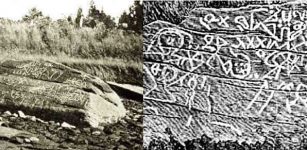Europe’s Earliest Culture Of Aurignacian People Made Amazing Images With Dots
AncientPages.com - Archaeologists have discovered16 engraved limestone blocks, created 38,000 years ago, during an expedition in France's Vézère Valley,
Vézère Valley was used as a shelter by the Aurignacian people who are considered Europe's earliest human culture.

The discovery gives evidence of the so-called ‘pointillist techniques’ used as early as 35,000 years ago. Image: R. Bourrillon
The discovery gives evidence of the so-called ‘pointillist techniques’ used as early as 35,000 years ago.
It is known that pointillism - a painting technique, in which small dots are used to create the illusion of a larger image – was adopted by 19th and 20th-century artists such as Georges Seurat, Vincent Van Gogh, Camille Pissarro, and Roy Lichtenstein.
“… now we can confirm this form of image-making was already being practiced by Europe's earliest human culture, the Aurignacian, " said New York University anthropologist Randall White, who led the excavation in France's Vézère Valley.

A graphic rendering of the recently published Blanchard aurochs illustrating the arrangement of punctuations in relation to the animal. Credit: R. Bourrillon
Major discoveries by White and his colleagues--which include images of mammoths and horses--confirm that a form of pointillism was used by the Aurignacian, the earliest modern human culture in Europe.
See also:
26,000-Year-Old Footprints In Chauvet Cave: Oldest Evidence Of Human-Canine Relationship
Prehistoric Volcanic Eruption Depicted In Chauvet Cave, France
35,000-Year-Old Carving Of Bird Found At Cantalouette, France
Earlier, many similar – though isolated - discoveries have already been made in Europe.
Limestone slabs decorated with dots depict for example, a rhinoceros, from the Grotte Chauvet in France, formed by the application of dozens of dots, first painted on the palm of the hand, and then transferred to the cave wall.
Earlier this year, researchers reported the uncovering of a 38,000-year-old pointillist image of an aurochs or wild cow--a finding that marks some of the earliest known graphic imagery found in Western Eurasia.
Another pointillist image is that of a woolly mammoth, discovered in a rock shelter of the same period known as Abri Cellier located near the previous find-site of Abri Blanchard.
Remarkably, the remaining 15 blocks, including the pointillist mammoth, one of three mammoth figures recognized during the new work at Cellier, had been left on-site by the 1927 excavators.
All these fascinating discoveries made by White and his team largely contributed to our knowledge about the earliest graphic arts in southwestern France by- 40 percent. T
The team includes researchers from the University of Arizona, the University of Toronto, the University of Toulouse, Paris' Museum of Natural History, and the University of Oxford.
AncientPages.com





















